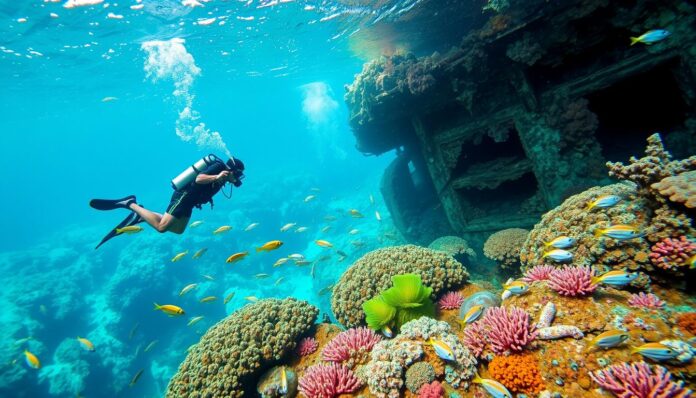| Best Time to Travel | December to April |
| What to Expect | Warm water, clear visibility, diverse marine life |
| Diving Conditions | Year-round, but best from December to April |
| Marine Life | Whale sharks, sharks, turtles, groupers, lobsters, fish |
Are you ready to explore the hidden underwater treasures of the Caribbean’s most mysterious diving destination? Cuba offers an extraordinary scuba diving experience. It challenges everything you thought you knew about underwater exploration.
With 5,646 kilometers of pristine coastline, Scuba Diving in Cuba presents an unparalleled marine adventure. The Caribbean Dive Sites here remain largely untouched. They offer divers a rare glimpse into some of the most preserved marine ecosystems in the world.
From the moment you descend into Cuban waters, you’ll be transported into a vibrant underwater world. This world is teeming with marine life. The average water temperature of 25°C creates perfect conditions for diving enthusiasts of all skill levels.
Key Takeaways – Scuba Diving in Cuba
- Cuba offers over 5,600 kilometers of diverse diving coastline
- Water temperatures consistently remain around 25°C
- Home to approximately 100 shark species
- Best diving season runs from December to April
- Pristine marine ecosystems with minimal human interference
- Multiple world-class dive sites including Jardines de la Reina
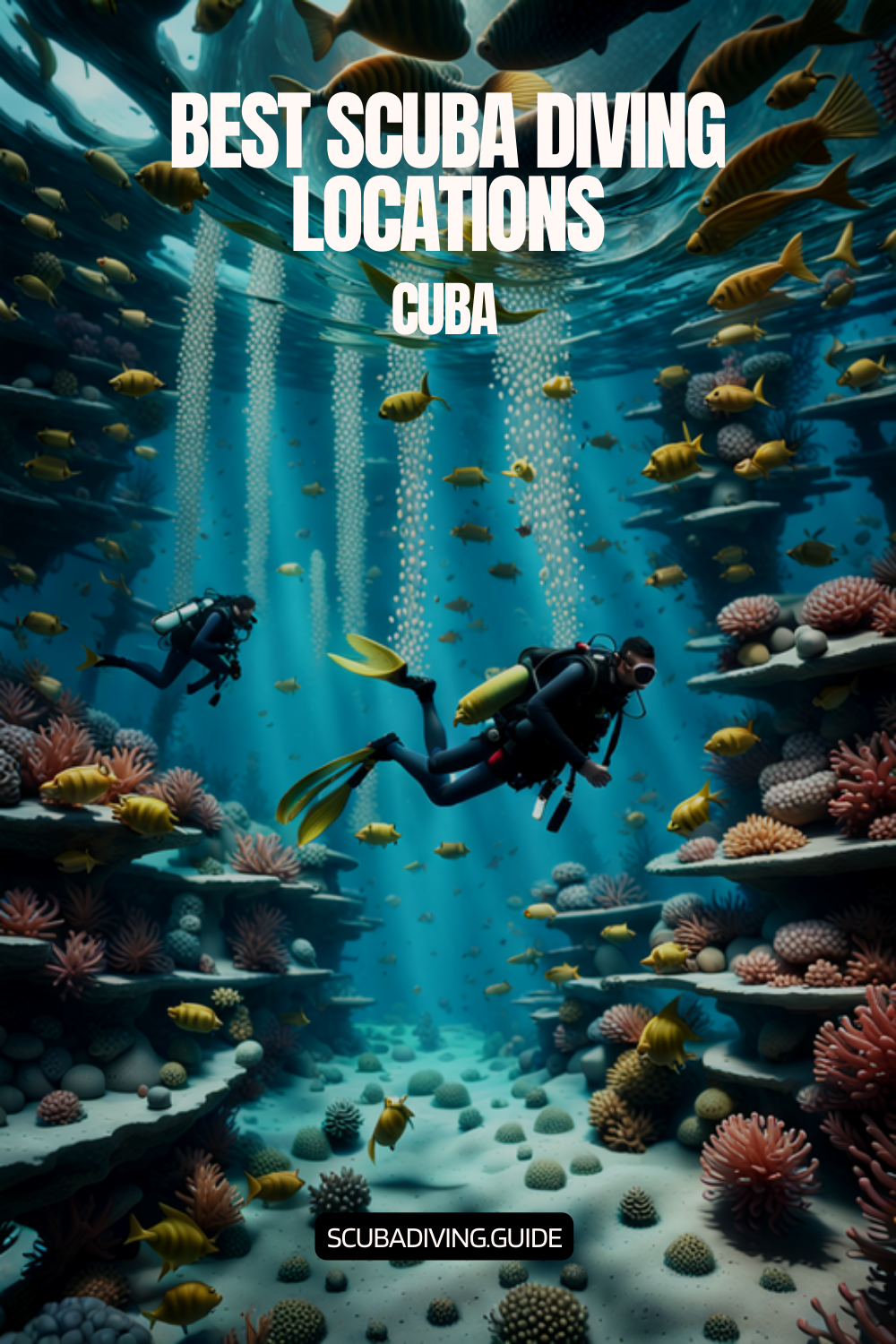
Overview of Scuba Diving in Cuba
Cuba is a hidden gem for scuba diving, with an underwater experience unlike other Caribbean spots. Its unique marine ecosystem offers divers a chance to explore untouched coral reefs and see a variety of marine life.
The waters of Cuba are home to an incredible variety of marine life. With nearly 100 shark species, it’s a paradise for those who love to explore the sea.
Why Choose Cuba for Your Diving Adventure?
- Pristine Coral Reefs in Cuba that remain largely untouched
- Exceptional marine conservation efforts
- Diverse underwater landscapes
- Limited commercial fishing in protected areas
Cuba’s commitment to marine preservation has made it a sanctuary for underwater life. Places like Jardines de la Reina show Cuba’s effort to keep marine ecosystems healthy.
Unique Features of Cuban Dive Sites
| Location | Dive Site Characteristics | Marine Life Highlights |
|---|---|---|
| Maria la Gorda | 50 excellent dive sites | Diverse underwater formations |
| Cayo Largo del Sur | 30+ dive sites | Eels, rays, lobsters |
| Bay of Pigs | 17 coral plant species | Vibrant marine ecosystem |
“Cuba offers divers an unparalleled underwater adventure with some of the most well-preserved marine environments in the Caribbean.”
Diving in Cuba is an extraordinary experience. You can dive in shallow waters full of life or explore deep underwater walls and caves. Cuba has something for every diver, from beginners to experts.
Preparing for Your Dive Trip
Starting a Dive Certification Cuba adventure needs careful planning. The Caribbean island offers a unique underwater experience. You must know what to expect and prepare well.
Getting ready for your Cuban diving trip involves important steps. These steps can greatly affect your underwater adventure.
Essential Gear for Scuba Diving
For Dive Certification Cuba, the right gear is key. Here’s what you should pack:
- Personal mask that fits well
- Wetsuit for the water temperature
- Diving certification documents
- Underwater camera
- Dive computer
“Proper preparation prevents poor performance, even underwater.”
Best Time to Visit Cuba for Diving
The best diving time in Cuba is from December to April. During this period, you can expect:
- Water temperatures around 25°C
- Great underwater visibility
- Low cyclone risk
- Comfortable diving conditions
Dive Certification Cuba has specific needs. Make sure you have:
- Valid medical insurance
- Proof of return ticket
- Cuba Tourist card (about $100)
- Retained documents for 5 years
Pro tip: Always check your diving skill level against specific site requirements before booking your adventure.
Top Scuba Diving Locations in Cuba
Cuba is home to some of the most amazing diving spots. Each spot has its own unique underwater world. From beautiful marine reserves to dives through history, Cuba offers an unforgettable adventure.
The waters of Cuba are full of different marine environments. This attracts divers from all over. You can find everything from shallow reefs to deep walls, perfect for all levels.
Jardines de la Reina Archipelago: A Marine Paradise
The Jardines de la Reina is a stunning marine reserve along Cuba’s southern coast. It stretches 93 miles and is a top spot for divers. Only a few hundred get to dive here each year, keeping it pristine.
- Marine reserve for over 25 years
- Home to six shark species
- Exceptional marine ecosystem preservation
“A diving experience in Jardines de la Reina is like entering an untouched underwater world” – Marine Conservationist
Varadero: Beachside Diving Retreat
Varadero is great for divers with over 20 sites near its beautiful beach. You can dive in both reef and wreck environments. The dive zone is huge, covering 16 km.
| Dive Site Characteristic | Details |
|---|---|
| Number of Dive Sites | 20+ |
| Beach Length | 20 km |
| Dive Zone Span | 16 km |
Bay of Pigs: A Historical Diving Destination
The Bay of Pigs is 100 miles from Havana. It’s known for its history and amazing underwater sights. Divers can see a stunning coral wall that goes down 300 meters.
- Visibility ranges 20-30 meters
- Water temperatures 22-29˚C
- Fascinating coral formations
These spots in Cuba are just a taste of what’s under the sea. Cuba is a true diving paradise.
Marine Life to Expect
Cuba’s underwater world is full of life and color. Divers will find an underwater paradise that’s as amazing as the best diving spots around the world.
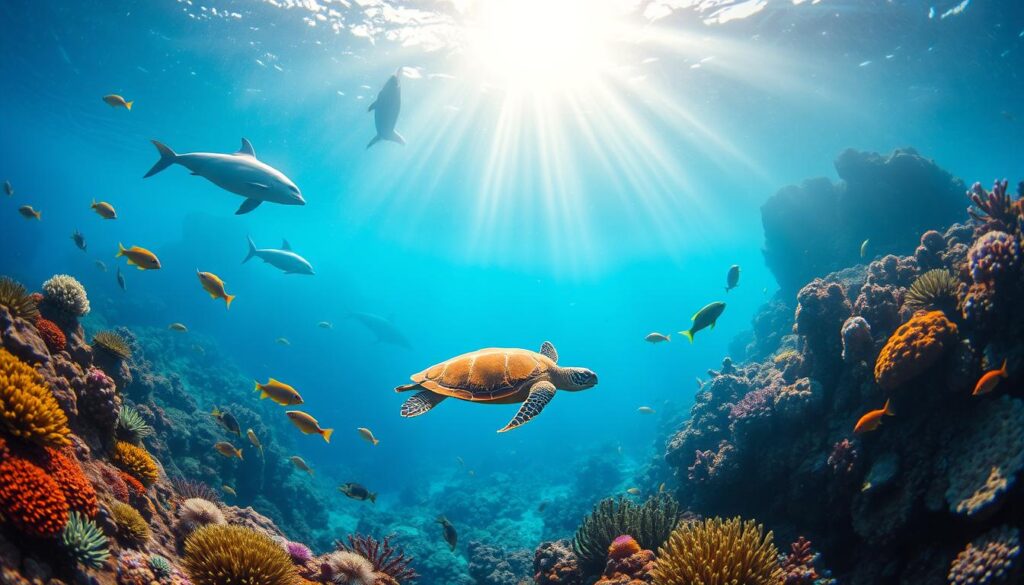
The Caribbean waters around Cuba are home to many marine creatures. This makes it a top spot for those who love the sea. With clear water, divers can see up to 40 meters below.
Coral Reefs: The Underwater Forests
Cuba has the second biggest barrier reef system in the world. Divers will see:
- 50 unique coral species
- Over 200 varieties of marine sponges
- Intricate coral formations in various colors and shapes
Unique Fish Species
The marine life in Cuban waters is incredible. Divers will see many fish species, including:
| Fish Category | Notable Species |
|---|---|
| Tropical Fish | Parrotfish, Angelfish, Clownfish |
| Predatory Fish | Barracudas, Groupers, Snappers |
| Unique Creatures | Lionfish, Morays, Puffers |
Larger Marine Creatures
Marine Life in Cuban Waters includes big species that make diving unforgettable:
- Hawksbill sea turtles
- Spotted eagle rays
- Caribbean reef sharks
- Silky sharks in Jardines de la Reina
“The underwater world of Cuba is like a living, breathing masterpiece of marine biodiversity.” – Marine Biologist
Water temperatures in Cuba range from 22°C in December to 29°C in July. This makes diving comfortable all year, best from December to mid-April.
Diving Certifications and Training
Exploring Dive Certification Cuba opens up exciting opportunities for underwater enthusiasts. The Caribbean island offers unique training experiences for divers of all skill levels. Specialized schools provide thorough diving education.
Diving certifications in Cuba present a distinctive learning environment. While PADI has limited presence, local schools offer exceptional training. Experienced instructors bring deep knowledge of Cuban marine landscapes.
Recognized Diving Schools in Cuba
Several prominent diving certification organizations operate in Cuba, with Scuba Schools International (SSI) being a primary provider. SSI brings impressive credentials:
- Operating for over 40 years
- Present in more than 110 countries
- Educational materials available in 30+ languages
- More than 2,500 international service centers
Courses for Beginners and Professionals
Dive Certification Cuba offers multiple course options for aspiring divers:
- Try Scuba Diving – Entry-level course ($80)
- Open Water Diver Course – Complete certification ($390)
- Minimum age: 10 years old
- Maximum depth: 60ft/18M for certified divers
- Course duration: 3-4 days
- Advanced Open Water Certification
“Learning to dive in Cuba is not just about certification, but experiencing the rich underwater world of the Caribbean.”
With average water temperatures of 26 degrees Celsius and visibility reaching 40 meters, Cuba provides an ideal environment for dive training and certification.
Environmental Considerations
Cuba is a leader in marine conservation, protecting its underwater worlds with great care. The country’s efforts to save Coral Reefs in Cuba are a model for the world.
Conservation Efforts in Cuban Marine Environments
Cuba’s long coastline of about 5,700 km shows its strong marine protection plan. The National System of Protected Areas (SNAP) is a big step towards saving ecosystems.
- Over 50 coral species flourish in Cuban waters
- 250 natural reserves cover 20% of the country’s territory
- Marine protected areas limit annual visitor access
Responsible Diving Practices
Divers are key in keeping Coral Reefs in Cuba healthy. By diving responsibly, they help protect these fragile marine areas.
“Preservation starts with understanding and respecting the marine ecosystem.”
| Conservation Strategy | Impact |
|---|---|
| Marine Protected Areas | Limits human interference |
| Community-Based Projects | Involves local stakeholders in conservation |
| Annual Environmental Permits | Ensures sustainable tourism practices |
Divers can help by following important rules:
- Avoid touching coral formations
- Use reef-safe sunscreen
- Maintain proper buoyancy control
- Respect marine life habitats
Cuba’s dedication to marine conservation means future generations can enjoy its stunning underwater beauty.
Diving Regulations in Cuba
Scuba diving in Cuba needs careful planning and knowing the local rules. Understanding these rules helps ensure a safe and fun dive in this Caribbean gem.
Safety Guidelines for Divers
Before diving in Cuba, divers must follow certain safety steps. The sea demands respect and careful attention.
- Obtain basic open water diver certification
- Follow a 24-hour no-fly rule after diving
- Wear recommended 5mm wetsuit during dry season
- Maintain awareness of local marine conditions
Permits and Legal Requirements
Scuba diving in Cuba has several legal points for international visitors to know.
| Requirement | Details |
|---|---|
| Tourist Card | Mandatory for entry into Cuba |
| Passport Validity | Must be valid for entire stay |
| Travel Authorization | U.S. citizens require Treasury Department program participation |
“Diving in Cuba is not just an adventure, it’s a commitment to marine conservation and responsible tourism.” – Cuban Marine Research Team
Cuba’s reef system is among the most protected in the Caribbean. The Blue Sanctuary program manages marine parks with strict rules. These rules limit visitor numbers and use rotation systems for dive sites.
Places like Cayo Coco, Varadero, and Isla de la Juventud offer great diving experiences. Divers who prepare and respect local rules will have an unforgettable dive.
Popular Dive Tours in Cuba
Exploring Cuba’s underwater wonders needs careful planning. Liveaboard Diving Cuba is a great way to see remote marine spots. It lets you discover the island’s untouched underwater beauty.
Cuba offers unique chances to see untouched marine ecosystems. Diving experiences range from guided tours to solo expeditions. Each has its own benefits for underwater lovers.
Guided Tours vs. Independent Diving
Choosing between diving options in Cuba is important. Here are the main points to consider:
- Guided tours offer expert local knowledge
- Independent diving gives more freedom
- Liveaboard Diving Cuba gets you to remote places
- Professional guides improve safety and marine knowledge
Recommended Tour Operators
Picking the right tour operator is key for a great diving trip. Here are some top Cuban marine expedition operators:
| Operator | Specialization | Price Range |
|---|---|---|
| Avalon Diving Expeditions | Luxury Liveaboard | $4,490 – $6,500 |
| Cuba Marine Adventures | Guided Reef Tours | $3,200 – $4,800 |
| Jardines Dive Specialists | Remote Site Exploration | $3,800 – $5,200 |
“Diving in Cuba is not just an adventure, it’s a journey through one of the most pristine marine ecosystems in the Caribbean.” – Marine Exploration Magazine
Liveaboard Diving Cuba offers a deep dive experience. Places like Jardines de la Reina are protected. They limit visitors to just 900 a year. This keeps the environment safe while giving you an amazing underwater adventure.
Cultural Richness of Cuba
Scuba Diving in Cuba reveals a world of underwater beauty. But there’s more to Cuba than its clear waters. It offers a mix of marine adventures and cultural traditions.
Exploring Local Villages Post-Dive
Cuba’s coastal villages are perfect for connecting with locals. These small places offer real experiences that match the underwater world of Scuba Diving in Cuba.
- Visit traditional fishing communities
- Interact with local artisans
- Learn about maritime heritage
- Experience traditional music and dance
Cuban Cuisine to Try After Diving
After diving, try Cuba’s tasty food. It shows the country’s cultural mix and geography.
| Dish | Description | Recommended Pairing |
|---|---|---|
| Ropa Vieja | Shredded beef in tomato sauce | Local rum |
| Moros y Cristianos | Black beans and rice | Fresh tropical juice |
| Cuban Sandwich | Roasted pork and ham | Cuban coffee |
“Cuba is one of the world’s most literary countries,” researchers at Manchester University discovered, highlighting the nation’s intellectual depth beyond its culinary and diving attractions.
Scuba Diving in Cuba is more than just diving. It’s a journey into Cuba’s culture. From local villages to traditional food, divers can dive deep into Cuba’s rich experiences.
Dive Accommodations: Where to Stay
Planning your diving adventure in Cuba needs careful thought about where to stay. Dive Resorts Cuba offer special places for those who love diving. They provide comfort and are close to amazing underwater worlds.
Choosing the right place to stay is key to a great diving trip. Cuba has many places to stay, for every budget and taste.
Beachfront Resorts with Diving Packages
Dive Resorts Cuba are great at combining luxury stays with top-notch diving. Many resorts offer:
- All-inclusive options with diving services
- Proximity to premier diving locations
- Professional dive centers on-site
- Equipment rental and storage
Budget-Friendly Alternatives
For those watching their budget, Cuba has affordable options that are just as good:
- Local guesthouses near diving sites
- Hostel accommodations with diving connections
- Homestays that offer a real Cuban experience
| Accommodation Type | Average Cost | Diving Proximity |
|---|---|---|
| Luxury Resort | $200-$500/night | Immediate beach access |
| Mid-Range Hotel | $100-$200/night | Close to dive centers |
| Guesthouse | $30-$80/night | Variable location |
“Choosing the right accommodation can transform your diving trip from good to extraordinary.” – Cuban Diving Expert
When picking your Dive Resorts Cuba, think about how close it is to dive sites, what services are included, and the value. Some resorts even give you free diving packages every day. This makes exploring the underwater world easy and fun.
Health and Safety While Diving
Scuba diving in Cuba needs careful planning and knowing about health risks. It’s important to stay safe to enjoy the underwater world. Knowing about medical issues and challenges is key for a great diving experience in Cuba.
Common Diving Injuries and Prevention
Diving injuries can be avoided with the right training and safety steps. Risks include:
- Decompression sickness
- Barotrauma
- Nitrogen narcosis
- Ear and sinus problems
To stay safe while diving in Cuba, follow these steps:
- Get full dive training
- Use the right gear
- Stick to safe depths and times
- Stay physically fit
Emergency Services in Cuban Waters
Being ready for emergencies is vital when diving in Cuban waters. The country’s medical help is limited, mainly in far-off places.
| Location | Hyperbaric Chamber | Approximate Response Time |
|---|---|---|
| Varadero | Available | Within 30 minutes |
| Havana | Available | Within 45 minutes |
| Cayo Coco | Limited | Up to 6 hours |
“Safety doesn’t happen by accident. Prepare, be aware, and dive responsibly.” – Diving Safety Expert
Having travel insurance that covers diving is mandatory for diving in Cuba. Make sure your policy includes:
- Medical emergencies
- Evacuation services
- Dive-related incidents
- COVID-19 coverage
See a doctor at least a month before your trip. Get any needed shots and talk about health tips for diving in Cuba.
Dive Photography Tips
Underwater Photography Cuba is a stunning place for photographers. The clear waters and colorful marine life are perfect for capturing amazing moments.
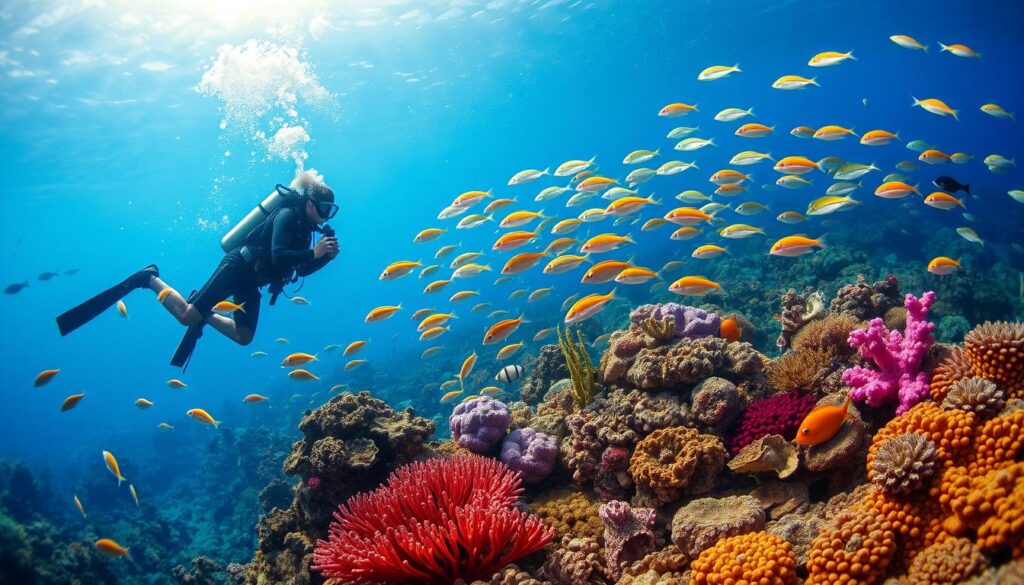
For those who love diving and want to take photos, they need special skills and tools. This is true for Cuba’s beautiful underwater world.
Capturing Underwater Moments
To take great underwater photos in Cuba, you need a plan and the right techniques. Experts suggest a few key tips:
- Focus on subject’s eyes for compelling compositions
- Position yourself at eye-level with marine subjects
- Minimize distance between camera and subject
- Use natural light when possible
Best Equipment for Underwater Photography
Choosing the right gear is key for Underwater Photography Cuba. Experts recommend:
| Equipment Type | Recommended Specifications |
|---|---|
| Camera Body | Nikon D500 with Nauticam Housing |
| Lenses | Tokina 10-17mm Fisheye, Nikon 105mm Macro |
| Strobe | Inon Z-240 Strobes |
Pro tip: Test camera settings indoors before diving to ensure optimal performance underwater.
“The key to great underwater photography is patience and practice” – Professional Marine Photographer
Cuban waters are perfect for underwater photography. They are clear up to 30 meters. You can see amazing marine life like silky sharks and colorful coral.
Cuba Recommended Scuba Diving Itinerary
To make the most of your scuba diving adventure in Cuba, it’s helpful to have a well-planned itinerary that allows you to explore the country’s diverse dive sites and experience its underwater wonders. Here is a recommended scuba diving itinerary that takes you through some of the top diving destinations in Cuba:
Day 1-3: Havana and Varadero
Start your journey in the vibrant capital city of Havana, where you can immerse yourself in Cuba’s rich history, culture, and architecture. Explore the city’s historic sites, vibrant neighborhoods, and iconic landmarks. After a couple of days in Havana, head to Varadero, a popular beach destination known for its stunning coastline and crystal-clear waters. Spend a day or two here, enjoying the beautiful beaches and taking part in introductory dives to acquaint yourself with the underwater world.
Day 4-6: Jardines de la Reina
From Varadero, make your way to the Jardines de la Reina (Gardens of the Queen) marine park, located off the southern coast of Cuba. This pristine marine reserve is a diver’s paradise, with its thriving coral reefs, impressive walls, and encounters with sharks, turtles, and an array of colorful fish species. Spend a few days exploring the underwater beauty of this protected area and take advantage of the exceptional diving opportunities it offers.
Day 7-9: María la Gorda and Isle of Youth
Next, venture west to María la Gorda, a remote diving destination renowned for its exceptional wall dives and vibrant coral formations. Spend a day or two exploring the underwater landscapes and encountering diverse marine life. From María la Gorda, continue your journey to the Isle of Youth (Isla de la Juventud), where you can dive in the famous Punta Frances Marine Park. Here, you’ll have the chance to explore captivating reefs and encounter intriguing species like groupers, snappers, and more.
Day 10-12: Cayo Largo and Cayo Coco
Travel southeast to Cayo Largo, an island known for its stunning beaches and excellent diving opportunities. Explore the coral gardens, swim alongside colorful fish, and discover intriguing shipwrecks that have become home to a variety of marine life. From Cayo Largo, make your way to Cayo Coco, part of the Jardines del Rey archipelago. Dive in the turquoise waters, marvel at the vibrant coral reefs, and enjoy encounters with tropical fish and other fascinating marine creatures.
Day 13-15: Guardalavaca and Santa Lucía
For the final leg of your scuba diving itinerary, head to the northern coast of Cuba, starting with Guardalavaca. This area boasts picturesque turquoise waters, stunning coral formations, and underwater tunnels waiting to be explored. Dive alongside eagle rays, turtles, and a variety of reef fish. Finally, visit Santa Lucía, known for its expansive coral reefs and excellent visibility. Explore the walls adorned with gorgonian fans and encounter a range of marine species.
This itinerary provides a well-rounded experience of Cuba’s diverse dive sites, combining cultural exploration with thrilling underwater adventures. However, keep in mind that the duration of each stay can be adjusted based on your preferences and the time available for your trip.
Remember to check weather conditions, dive center availability, and dive site accessibility when planning your itinerary. It’s always advisable to consult with local dive operators or travel agencies to ensure the best diving experiences during your visit.
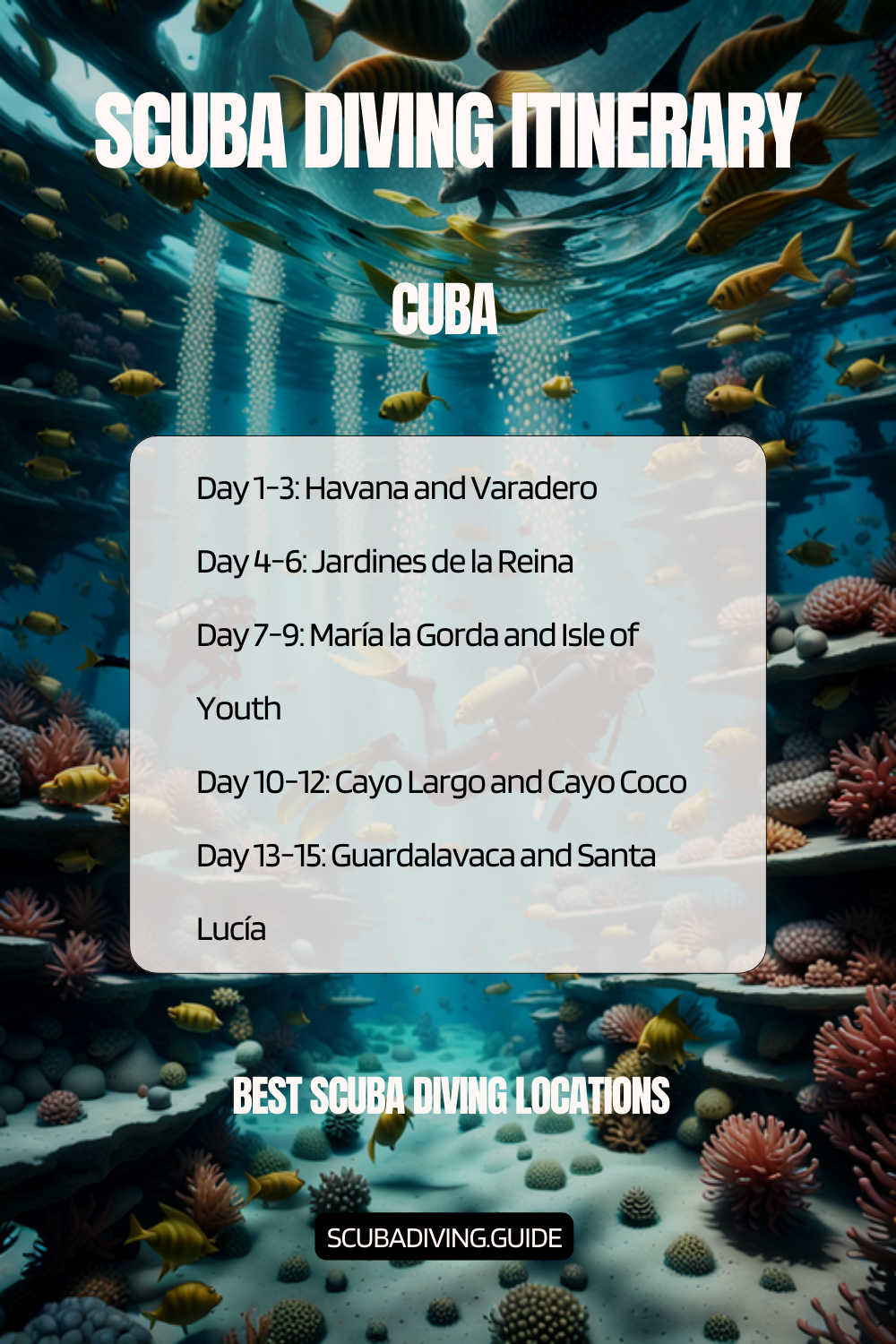
Other Countries to Consider
- Anguilla
- Antigua and Barbuda
- Aruba
- Bahamas
- Barbados
- Bonaire
- British Virgin Islands
- Cayman Islands
- Curaçao
- Dominica
- Dominican Republic
- Grenada
- Guadeloupe Islands
- Haiti
- Jamaica
- Martinique
- Montserrat
- Puerto Rico
- Saba
- Saint Barthélemy
- Saint Kitts & Nevis
- Saint Lucia
- Saint Vincent and the Grenadines
- Sint Eustatius
- Sint Maarten
- The Turks And Caicos Islands
- Trinidad and Tobago
- United States Virgin Islands
Conclusion: Dive into the Cuban Adventure
Scuba diving in Cuba is an amazing journey under the sea. It mixes beautiful marine life with rich culture. The Caribbean waters around Cuba are home to over 300 fish species and 150 coral types.
The clear waters and warm temperatures make diving perfect. You can see up to 150 feet and enjoy water between 75 and 85 degrees Fahrenheit.
Cuba’s dive sites are more than just underwater adventures. Places like the Garden of the Queens and the Bay of Pigs offer unique experiences. These sites mix marine life with cultural history.
With 95% of marine life found only in the Caribbean, every dive is special. You’ll see rare underwater worlds.
Recap of Essential Points
Snorkeling in Cuba lets you explore a well-kept marine environment. Dive spots like the Bay of Pigs have over 70 locations for all skill levels. It’s close to the U.S., just 90 miles away.
Call to Action: Plan Your Dive Trip Today!
Get ready for an unforgettable dive trip. Cuba offers amazing marine life and cultural experiences. Whether you’re an experienced diver or new to it, Cuba’s underwater world is waiting for you.
Start planning your Cuban diving adventure today. Discover a world of underwater wonders that will change how you see tropical marine environments.
FAQ – Scuba Diving in Cuba
Do I need a special permit to scuba dive in Cuba?
Most divers don’t need a special diving permit. But, you’ll need a tourist visa to enter Cuba. It’s wise to work with a licensed dive operator for any needed documents. Make sure you have travel insurance that covers diving.
What is the best time of year to go scuba diving in Cuba?
The best diving season in Cuba is from November to April. During this time, the water is warm (around 77-82°F) and visibility is great. Summer diving can be tough due to hurricanes and rain, which can ruin the conditions.
Are there any specific health requirements for diving in Cuba?
You need to be in good shape and have a valid dive certification. Dive operators often ask for a recent medical check, more so for advanced sites. Get a health check-up before your trip and bring any needed meds.
What marine life can I expect to see while diving in Cuba?
Cuba’s waters are home to many marine creatures. You might see nurse sharks, sea turtles, groupers, barracudas, and colorful tropical fish. The Jardines de la Reina archipelago is famous for its sharks and coral reefs.
How difficult is it to get dive equipment in Cuba?
Major dive resorts and operators offer equipment rentals. But, it’s best to bring your own essential gear. Some places might not have much equipment, so pack your own to be sure.
Do I need to speak Spanish to go diving in Cuba?
While basic Spanish is helpful, many dive operators speak English. Knowing some Spanish can make your experience better and help you talk to local guides.
What certification levels are recognized in Cuba?
Cuba accepts major dive certifications like PADI, SSI, and NAUI. Most sites welcome open water divers. But, some spots might need more experience or certifications.
Are there any conservation rules I should be aware of while diving?
Cuba has strict marine laws. Divers must not touch or remove marine life, coral, or artifacts. Follow your guide’s instructions and dive responsibly to protect the marine ecosystem.
What are the typical costs for diving in Cuba?
Diving costs vary by location and experience. Single dives cost $50 to $100. Multi-day packages or liveaboard trips can be $1,000 to $3,000. Remember to budget for equipment rental and travel.
Is underwater photography allowed in Cuban waters?
Underwater photography is usually allowed, but some areas might have rules. Always check with your operator. Bring gear suitable for the Caribbean and be careful not to disturb marine life.
